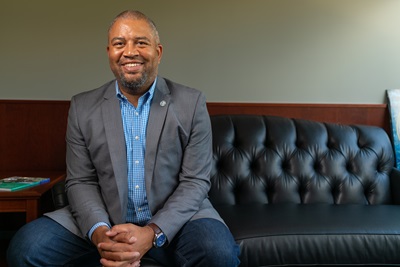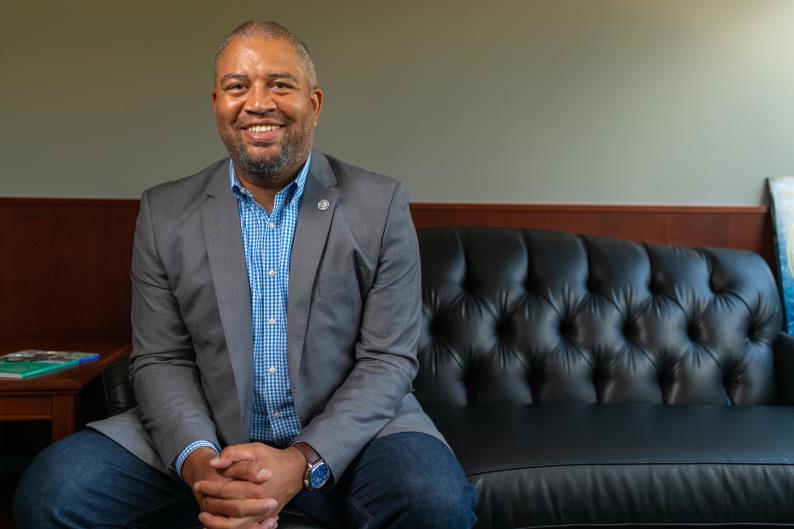Seeing Clearly for the First Time
Degeneration Sen. Marshall Bullock notes that many people take sight for granted.
Sen. Marshall Bullock notes that many people take sight for granted.
He doesn’t. Not after watching his legally blind mother get treated for macular degeneration and other eye issues. And not after dealing with his own extreme nearsightedness since he was young.
“My parents noticed that I was six inches from the TV,” says Marshall, 51, a Michigan State Senator who represents a portion of Detroit as well as Allen Park, Lincoln Park and Southgate. “I wore glasses up until high school, when hard contacts became an option.”
A lifetime of visual impairment
Even with corrective lenses, Marshall faced lifestyle challenges.
“Growing up, I was an active kid,” he says. “You know in my generation, we played outdoors, and rough. And so the plastic lenses in your glasses were extraordinarily thick, and if you didn’t get the sides beveled down, when you’d get bumped in the face, it would leave a socket ring around your eye.”
As an extremely nearsighted adult with a high double-digit index prescription, he faced other limitations, which people sometimes didn’t understand.
“Mundane activities where people assume you can see, like going into a restaurant and the menu’s on the screen behind them, and you can’t see the ingredients on a sandwich,” Marshall says. “You ask what’s on it, and they turn to you as if you can’t read, or you’re not very smart. But for me, it was my vision.”
Marshall’s vision issues also affected his work life.
“Folks see you sitting close to the computer screen, or see you read something that’s close, even on your phone, and they think you must be blind,” Marshall says. “Yes, I am, I can’t see!”
But in his late ‘40s, it got even worse when his vision started to get hazy.
“I remember I was shooting a segment for the senators, and I couldn’t read the monitor to say my lines, so I had to memorize them,” Marshall says. “And then even when I was giving speeches on the floor, I would have to print them at a 24 point font, so I could actually see the words, without having to look down or hold the paper close.”
A new diagnosis
As his vision got progressively worse, he got a new prescription, but it didn’t help. He started facing even more challenges, including not being able to pass his driver’s test.
Given his family history of vision issues such as macular degeneration, he was concerned. After doing some research on his own and first trying another specialist, Marshall was introduced to Henry Ford ophthalmologist David Crandall, M.D., where he learned he had cataracts in both eyes.
At 51, Marshall was a little younger than normal for developing a cataract, which is a clouding of the normally clear lens in the eye. Everyone will develop cataracts as they age. While this often happens after age 60, some people may begin developing them in their 40s or 50s. In addition, while a cataract often forms slowly and some may not notice vision changes until it grows, Marshall’s case was different.
“Dr. Crandall explained that since my vision was high index, even a small blemish disrupted my vision,” Marshall says.
Preparing for cataract surgery
Once Marshall was diagnosed, Dr. Crandall discussed cataract surgery, which is the only effective treatment for cataracts. During this procedure, the ophthalmologist breaks up the cataract (and the eye’s natural lens with it), and replaces it with an artificial lens.
Even here, Marshall faced unique challenges due to his vision history.
“I wore hard contacts for so long that my corneas had a natural curve to them,” he says. “So I had to stop wearing those, and wait until my corneas decompressed to their natural state, before Dr. Crandall could get a good gauge on the prescription for my replacement lens.”
After about two months, Marshall’s corneas had decompressed to their natural size, and he underwent cataract surgery on his left eye. He notes that he was probably less nervous than most.
“My mother had cataract surgeries and other types of procedures, and my sister had a cornea transplant, so I wasn’t afraid, just anxious to see how it would turn out.”
It also helped that Dr. Crandall explained the procedure to him. “He was very knowledgeable, and he wasn’t speaking in a language above my head,” Marshall says. “He let me know how the operation would work, how long it would last and what to expect.”
A game changer
Even so, Marshall was surprised at how quickly his vision improved.
“The procedure lasted probably 16 or 18 minutes, and I was patched up that first day,” Marshall says. “But the next day I went in for a follow-up, and I could see things that I hadn’t been able to see, even as a kid. I could read the magazine on the wall in the hallway, so that was just something phenomenal for me. After my first eye was done, my quality of life changed immediately.”
A couple of months later, Dr. Crandall performed cataract surgery on Marshall’s right eye.
Since then, Marshall has noticed several ways that his life has changed. He’s gone swimming in pools and the ocean, without having to worry about chlorine or salt water irritating his contacts. He can drive at night, which he wasn’t able to do as much before. He can see street signs and mile markers on the highway with clarity. He can see people across the room and recognize them. And perhaps most importantly, reading is easier.
“Being in the Senate, you’re reading all kinds of bills and stories and catching up on news and updates and briefings,” he says.
While Marshall has noticed these and other changes, some habits are hard to break.
“I still reach for the nightstand in the morning for my glasses,” he says. “Or when I get up and go to the bathroom, I open up the medicine cabinet to put my contacts in, and I go, ‘Hey! I don’t need this anymore!’ It was definitely a game changer for me.”
Marshall is thankful for the dramatic change in his vision.
“Dr. Crandall was very warm and caring,” Marshall says. “He answered questions, he asked questions and I just had a great overall experience.”
.svg?iar=0&hash=F6049510E33E4E6D8196C26CCC0A64A4)

/hfh-logo-main--white.svg?iar=0&hash=ED491CBFADFB7670FAE94559C98D7798)
